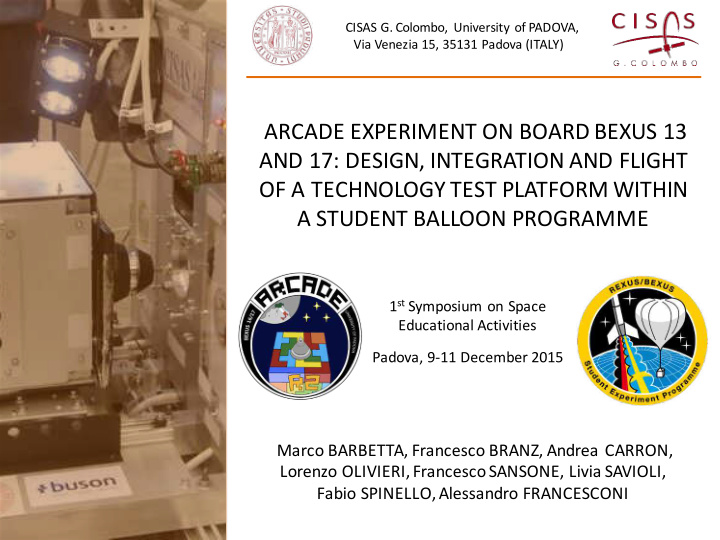



CISAS G. Colombo, University of PADOVA, Via Venezia 15, 35131 Padova (ITALY) ARCADE EXPERIMENT ON BOARD BEXUS 13 AND 17: DESIGN, INTEGRATION AND FLIGHT OF A TECHNOLOGY TEST PLATFORM WITHIN A STUDENT BALLOON PROGRAMME 1 st Symposium on Space Educational Activities Padova, 9-11 December 2015 Marco BARBETTA, Francesco BRANZ, Andrea CARRON, Lorenzo OLIVIERI, Francesco SANSONE, Livia SAVIOLI, Fabio SPINELLO, Alessandro FRANCESCONI
CONTENTS Ø EXPERIMENT OBJECTIVES Ø EXPERIMENT OVERVIEW (2013) • Docking Subsystem • Motion Control Subsystem • Proximity Navigation Subsystem Ø ARCADE EVOLUTION Ø FLIGHT RESULTS Ø LESSONS LEARNED Ø CONCLUSIONS Padova - 9/12/2015 1st Symposium on Space Educational Activities 2
EXPERIMENT OBJECTIVES Primary Objectives: • To test innovative solutions for proximity navigation , attitude control and docking suited for miniature autonomous space and aerial vehicles • To evaluate disturbances affecting operations at different altitudes on board a stratospheric balloon offered by the REXUS/BEXUS programme • To relate performances to disturbances Secondary Objectives: • To collect environmental data (pressure/temperature profiles) • To determine wind direction and speed Padova - 9/12/2015 1st Symposium on Space Educational Activities 3
EXPERIMENT OVERVIEW (2013) Main Elements: SMAV (SMAll Air Vehicle) • PROXBOX PROXBOX (PROXimity BOX) • STRUT (STRUcTure) • Docking Subsystem • Navigation Subsystem • SMAV Wind Sensors • STRUT Webcam • Balloon frame Padova - 9/12/2015 1st Symposium on Space Educational Activities 4
DOCKING SUBSYSTEM Based on Soyuz and ATV probe-drogue configuration • Probe length of 10 cm (SMAV size: 20x20x20 cm) • Up to 10° of allowable misalignment • Padova - 9/12/2015 1st Symposium on Space Educational Activities 5
MOTION CONTROL SUBSYSTEM Main Goal & Architecture: Actively control SMAV yaw movements • Main actuator: custom reaction wheel • Backup solution: DC motor b/w SMAV and STRUT • State-Space Control State feedback + integral controller • Disturbances rejected outside feedback loop • Linear movements not influencing attitude • SMAV Reaction Wheel Backup solution: manual-tuned PID controller • Padova - 9/12/2015 1st Symposium on Space Educational Activities 6
PROXIMITY NAVIGATION SUBSYSTEM Sensor selection: Compactness (minor part of SMAV volume) • Simplicity (hardware components & software computational burden) • IR LED custom relative navigation IR sensor based on radiation intensity measurement Sensor layout: IR LED emitter (pulsed at 10 kHz) on the PROXBOX • IR RECEIVERS Two IR receivers on the SMAV • Reconstruction of relative range ρ and yaw angle ψ • SMAV Padova - 9/12/2015 1st Symposium on Space Educational Activities 7
ARCADE EVOLUTION 2010 - 2013 DESIGN PHASE (10/2010 – 6/2011) 1) Concept definition 2) Baseline configuration selection 3) Detailed design 1) Selection Workshop 2) PDR 3) CDR RE-FLIGHT (11/2012 – 10/2013) INTEGRATION & TEST PHASE (6/2011 – 9/2011) • Substitution of damaged or obsolete h/w 4) Integration and acceptance 4) IPR & EAR • Complete re-writing of software 5) Launch Campaign • Other design upgrades (October 2011) • Mass reduction 6) BEXUS 17 flight -2013 Unsuccessful flight because Successful flight!!! of critical software failure 5) BEXUS 13 flight -2011 Padova - 9/12/2015 1st Symposium on Space Educational Activities 8
FLIGHT RESULTS (1/2) Docking system Successful release of the SMAV • 2 1 3 4 Thermal deformation: in-flight • modification of actuators stroke Two complete docking and release • procedures Motion control system Backup motor successfully pointing and moving the SMAV • Reaction wheel successfully tested with both PID and State-Space controls • State-Space Controller Manoeuvre PID Controller Manoeuvre Padova - 9/12/2015 1st Symposium on Space Educational Activities 9
FLIGHT RESULTS (2/2) Proximity navigation system Automatic calibration of photodiodes • electronics (temperature-dependant) Real-time estimation with on-board software: • accuracy of 17 mm – 2.7 deg Post processing: accuracy of 5 mm – 1.5 deg • Thermal control system and wind sensors Experiment temperature always within operational range • Estimation of wind torques on the vehicle • Padova - 9/12/2015 1st Symposium on Space Educational Activities 10
LESSONS LEARNED (1/3) Experiment Design Don’t fall in love with design ideas but • ask to experts for what already exists The simpler the better: a simple • solution, although less elegant, is preferable Always opt in favour of COTS against self- • built components Don’t underestimate time to allocate to • software developing. Even in integration is incomplete Padova - 9/12/2015 1st Symposium on Space Educational Activities 11
LESSONS LEARNED (2/3) Launch Campaign Finalize as early as possible the integration. • Worst problems happen at 99% of progress. Drop things if needed Don’t change software at last even if it’s soooo • easy Have spare parts both for COTS and self-built • components Make systems serviceable • Don’t rely on telecommand for the success of • the experiment Padova - 9/12/2015 1st Symposium on Space Educational Activities 12
LESSONS LEARNED (3/3) Procurement and Shipping Freeze long lead time components as early as possible • Use components from big distributors • Consider Li-SOCl2 battery shipping. Couriers are scared of hazmat! • Testing Test flight configuration in the most realistic way • Give tests a priority. Test first things which are • likely to have problems in your mind Outreach and Funding Good outreach means funding • Good outreach devotes a full-time person – or even more. • Padova - 9/12/2015 1st Symposium on Space Educational Activities 13
CONCLUSIONS Important scientific and technologic results • Tested critical technologies for: • Docking • Relative navigation • Attitude control • Know-how of the team seriously improved • Big experience about space programs and deadline-driven teamwork • HOW MANY ERRORS BE AVOIDED THANKS TO THIS EXPERIENCE? Padova - 9/12/2015 1st Symposium on Space Educational Activities 14
CISAS G. Colombo, University of PADOVA, Via Venezia 15, 35131 Padova (ITALY) THANK YOU FOR ATTENTION ! 1 st Symposium on Space Educational Activities Padova, 9-11 December 2015
Recommend
More recommend